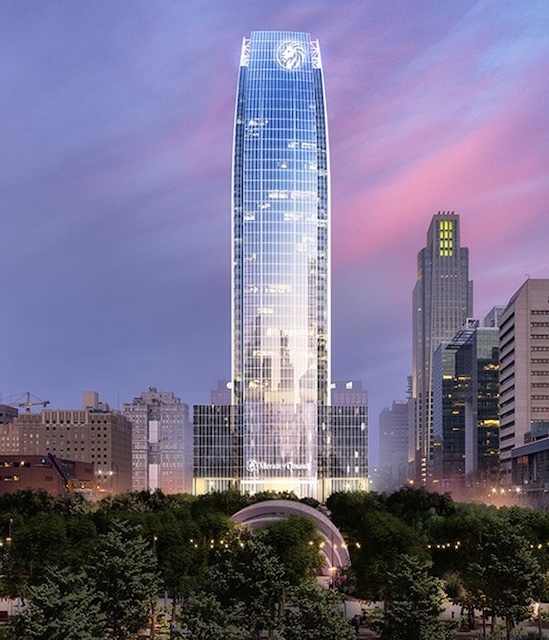Mutual of Omaha is building a new headquarters in downtown Omaha, which at first appears to be a revival of downtown fortunes. But the company has 4,000 employees in the Omaha area, and the new headquarters will have room for no more than 2,500 of them, as the rest are expected to work from home on any given day.
Mutual of Omaha’s planned skyscraper may become the tallest building in Omaha — but it will only have enough room for about 60 percent of the company’s Omaha-area employees.
So why locate downtown? Maybe because of the $68.6 million in subsidies — 16 percent of the building’s cost — the city is giving to the insurer.
Similarly, bank service company Deluxe opened a new headquarters in downtown Minneapolis. Again, that suggests some faith in the recovery of downtown employment — but the new headquarters is only a third of the size of its old one since most of its employees will work remotely at least part of the time.
Jamie Dimon, of JPMorgan Chase, estimates that the bank’s offices will need only 60 desks for every 100 employees due to the other 40 working remotely on any given day. Even before the pandemic, the idea that getting everyone to work in the same office would increase collaboration was losing favor.
Downtowns are the main market for transit ridership. If they lose 40 percent of their workers on any given day, then transit will lose at least as many riders. Of course, other companies may fill the spaces downtown to take advantage of declining rents, but many of their employees will work remotely part time as well. Unless they are given millions in subsidies, I doubt many more companies will be planning more downtown skyscrapers.









The human brain does not really appreciate buildings that even just look like they are liable to fall down — especially post-9/11, when several gigantic buildings actually did fall down. New York does not require any more skyscrapers, and cities in US don’t either. You can have tall buildings, towers, spires, churches…. high rise buildings become enormous traps in real estate market.
Without thinking much about it, most people prefer traditional architecture. Now it seems as if more detailed and ornamental styles of design for buildings and cities are not only more popular but more natural and more healthy. These designs evoke buidings, never more than a few stories. Moderate density capacities where walkability, bike, transit, micro transit friendliness, doesn’t imply “CRAMMED” or stuffed or “Density”. This is not smart growth but marketable…. new urbanism. Density is a loveable, laughable pet subject….
– Environmentalists, who argue that densely populated cities are the solution to lower the energy requirements for transportation and living. On the other hand, the solar envelope shows that above a certain threshold, density can also raise energy requirements, in particular heating, cooling and daylighting.
– Sprawl advocates use density as an argument for more segregated housing types which many have used for decades to keep out social riff raff.
BOTH sides have their bugs up their butts….
I said before you can build artificial islands for what it costs for the infrastructure of major highrise laden cities.
A wonderful comparison between a “Texas donut” (also called a Dallas donut) where a single building/network of development wrapped around a parking deck………………
https://images.squarespace-cdn.com/content/v1/53765fd8e4b0c4a5e910ed43/1444320818628-LQ4QTHC1WAJ3XSOIY2E5/Cover+Image_B.jpg
and “Charleston’s style” traditional architecture. It comes from design consultants Bevan and Liberatos.
https://images.squarespace-cdn.com/content/v1/53765fd8e4b0c4a5e910ed43/1444320818835-14MRUNSIP02CV8Z82YAE/Cover+Image_A.jpg
The Charleston system has 13 gardens, vs. none in the donut. There are 68 porches in the Charleston block, zero in the donut.
The donut does have more parking spaces, although the Charleston block has plenty for urban living.
Small Buildings are Highly Adaptable….Small buildings are more adaptable for reuse as requirements change over time. Flexible building stock is essential for encouraging small businesses, local start-ups. Big buildings have almost no adaptive re-use…once built is destined to a 30-40 year shelf life…..
A couple interesting notes on Deluxe:
a) Downtown Minneapolis lost ~1,250 – !,500 jobs when TCF moved out of downtown a few years back.
b) Deluxe deal is moving into some of the vacated TCF space. Word on the street is they got a sweet deal.
c) Deluxe is cashing in on it’s 300 acre Shoreview campus; they’ve sold it for a big chunk $$$$$$ to a developer
d) Deluxe is going form ~300,000 sq ft in Shoreview to ~95,000 sq ft. downtown.
e) Deluxe is moving ~500 – ~525 workers to the downtown location.
A lot of folks are right, Dowtown’s ain’t dieing.
They’re downsizing.
A lot.
And that could get ugly for city’s like Minneapolis that count on their downtown core not only for most of it’s economy but most of it’s tax revenue.
One thing you can be sure of: The Antiplanner won’t like the “Charleston” option for downtown housing any more than the crude Texas option due to high density.
Another thing. Shaving the commuter peaks off of downtown rush hour could actually improve transit economics and overall ridership IF transit agencies shift resources away from oversupplying peak commuter service to downtowns towards more all-day service that meets a much wider variety of travel markets than the downtown commute.
It certainly makes sense to convert peak-oriented commuter rail into all day regional rail, like S-Bahns and regional rail in Germany and other European countries. These serve commuters, but also provide all-day service every 30-60 minutes depending on trip length and potential ridership. Pre-pandemic practices such as Chicago’s Metra running frequent 10-car trains during the peaks and every 90 minutes during the day were hopelessly obsolete BEFORE COVID.
No use running a train every hour if no one is going downtown nor lives there.